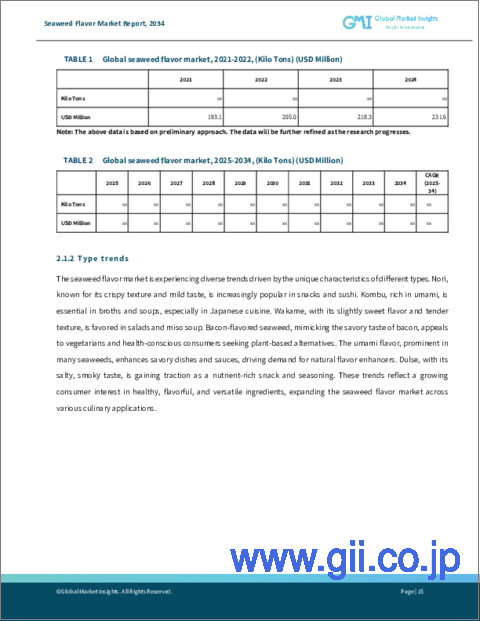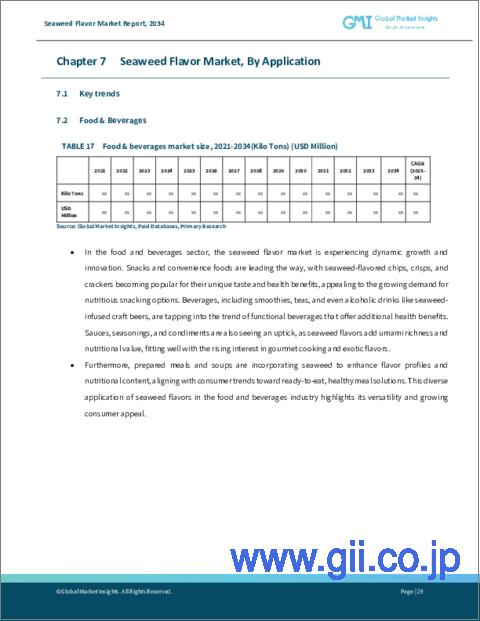|
|
市場調査レポート
商品コード
1518465
海藻フレーバー市場:タイプ別、形態別、用途別、流通チャネル別、2024年~2032年の予測Seaweed Flavor Market - By Type By Form By Application By Distribution Channel & Forecast, 2024 - 2032 |
||||||
カスタマイズ可能
|
|||||||
| 海藻フレーバー市場:タイプ別、形態別、用途別、流通チャネル別、2024年~2032年の予測 |
|
出版日: 2024年04月19日
発行: Global Market Insights Inc.
ページ情報: 英文 350 Pages
納期: 2~3営業日
|
- 全表示
- 概要
- 目次
海藻フレーバーの市場規模は、2024-2032年にCAGR6.1%以上を記録し、天然素材やクリーンラベル製品への需要増が牽引します。
飲食品インサイダーによると、消費者の大多数(約75%)は、クリーンラベルの原材料を使用した製品により高い金額を支払うことを望んでいます。自然なうま味と栄養価の高さで知られる海藻は、持続可能なクリーンラベル原料として消費者の嗜好に合っています。また、ビタミン、ミネラル、抗酸化物質、ユニークな生物活性化合物を豊富に含み、その潜在的な健康効果がますます認識されるようになっています。メーカー各社は、海藻エキスやパウダーを様々な食品に配合し、風味を高めると同時に、透明性や健康志向を求める消費者の要望に応えています。
海藻フレーバー産業は、タイプ、形態、用途、流通チャネル、地域によって分類されます。
昆布セグメントは、その豊かなうま味と栄養プロファイルにより、2032年まで急速に成長します。昆布は日本料理の基本的な材料であるだし汁を作るのに一般的に使用され、その風味を高める特性から世界中で様々な料理に使われるようになっています。うま味に対する消費者の関心が高まり、料理の境界線が曖昧になり続ける中、昆布は多様な味覚嗜好と料理の革新に対応します。
海藻エキスやパウダーが天然風味調味料や風味調味料として幅広い料理用途で使用されるようになっていることから、料理用素材分野は2032年まで安定したペースで拡大するとみられます。スープやソースからスナックや調味料に至るまで、海藻は食品に深み、複雑さ、栄養価を加えます。人工的な添加物を使用せずにうま味を付与できる海藻の能力は、クリーンラベル製品を求める消費者の嗜好に合致しています。料理素材における海藻の多用途性は、味、健康、持続可能性を優先する現代的な食品配合を形成する上で海藻が果たす役割を強調しています。
欧州の海藻フレーバー市場価値は、自然で健康的な食品を求める旺盛な消費者需要に牽引され、2032年まで速いペースで成長します。同地域は料理の伝統が強く、植物ベースの食生活の普及が進んでいることが、海藻フレーバーの人気の高まりに寄与しています。フランス、スペイン、英国のような国々は、スナック、調味料、調理済み食品を含む様々な食品カテゴリーにおいて海藻入り製品の著しい成長を目の当たりにしています。さらに、持続可能な調達とクリーンラベル原料を促進する厳しい規制が、欧州での技術革新と市場拡大を促進しています。
目次
第1章 調査手法と調査範囲
第2章 エグゼクティブサマリー
第3章 業界洞察
- エコシステム分析
- バリューチェーン
- 主要メーカー
- 市場参入ルート
- 主要流通業者
- 新しい流通チャネル
- 業界全体の利益率
- 業界への影響要因
- 促進要因
- 市場の課題
- 市場機会
- 新市場/用途
- 成長可能性分析
- 原材料情勢
- 製造動向
- 技術の進化
- 持続可能な製造
- グリーン・プラクティス
- 脱炭素化
- 新原料
- 原材料価格動向(米ドル/トン)
- 米国
- 欧州連合
- 英国
- 中国
- 東南アジア
- GCC
- 製造動向
- 規制と市場への影響
- 貿易統計
- アンメットニーズ
- ポーター分析
- PESTEL分析
第4章 競合情勢
- 企業シェア分析
- 競合のポジショニング・マトリックス
- 戦略展望マトリックス
第5章 市場規模・予測:タイプ別、2021年~2032年
- 主要動向
- 海苔
- 昆布
- わかめ
- ベーコン
- 旨味
- ダルス
第6章 市場規模・予測:形態別、2021年~2032年
- 主要動向
- 粉末
- 液体
- エキス
第7章 市場規模・予測:用途別、2021年~2032年
- 主要動向
- 飲食品
- 料理素材
- 栄養補助食品とサプリメント
- 動物飼料
- 化粧品・パーソナルケア
- その他
第8章 市場規模・予測:流通チャネル別、2021年~2032年
- 主要動向
- 小売店舗
- オンライン小売
- フードサービス&ホスピタリティ
- 卸売業者
第9章 市場規模・予測:地域別、2021年~2032年
- 主要動向
- 北米
- 米国
- カナダ
- 欧州
- ドイツ
- 英国
- フランス
- イタリア
- スペイン
- その他欧州
- アジア太平洋
- 中国
- インド
- 日本
- 韓国
- オーストラリア
- その他アジア太平洋地域
- ラテンアメリカ
- ブラジル
- メキシコ
- アルゼンチン
- その他ラテンアメリカ
- 中東・アフリカ
- サウジアラビア
- UAE
- 南アフリカ
- その他の中東・アフリカ
第10章 企業プロファイル
- Acadian Seaplants Ltd
- Annie Chun's Inc
- Atlantic Holdfast Seaweed Company
- Dulse & Rugosa
- Eden Foods
- FritoLay
- Mara Seaweed
- Maine Coast Sea Vegetables Inc.
- Ocean's Halo
- Seamore Holding B.V.
- VitaminSea Seaweed
The Seaweed Flavor Market size will record over 6.1% CAGR during 2024-2032, driven by the increasing demand for natural and clean label products. According to Food & Beverage Insider, a majority of consumers, around 75%, are willing to pay more for products that feature clean label ingredients. Seaweed, known for its natural umami flavor and nutritional benefits, aligns well with the preferences as a sustainable and clean label ingredient. It is also rich in vitamins, minerals, antioxidants, and unique bioactive compounds, is increasingly recognized for its potential health benefits. Manufacturers are incorporating seaweed extracts and powders into various food products to enhance flavor profiles while meeting consumer demand for transparency and health-conscious choices.
The seaweed flavor industry is classified based on type, form, application, distribution channel and region.
The kombu segment will grow rapidly through 2032, owing to its rich umami taste and nutritional profile. It is commonly used to make dashi broth, a fundamental ingredient in Japanese cooking, and is increasingly incorporated into various dishes worldwide for its flavor-enhancing properties. As consumer interest in umami flavors grows and culinary boundaries continue to blur, kombu will cater to diverse taste preferences and culinary innovations.
The culinary ingredients segment will expand at a steady pace through 2032, as seaweed extracts and powders are increasingly used as natural flavor enhancers and savory ingredients in a wide range of culinary applications. From soups and sauces to snacks and seasonings, seaweed adds depth, complexity, and nutritional value to food products. Its ability to impart umami flavors without the need for artificial additives aligns with consumer preferences for clean label products. The versatility of seaweed in culinary ingredients underscores its role in shaping modern food formulations that prioritize taste, health, and sustainability.
Europe seaweed flavor market value will grow at a fast pace through 2032, driven by robust consumer demand for natural and healthy food products. The region's strong culinary heritage and increasing adoption of plant-based diets contribute to the growing popularity of seaweed flavors. Countries like France, Spain, and the United Kingdom are witnessing significant growth in seaweed-infused products across various food categories, including snacks, condiments, and ready-to-eat meals. Moreover, stringent regulations promoting sustainable sourcing and clean label ingredients are fostering innovation and market expansion in Europe.
Table of Contents
Chapter 1 Methodology & Scope
- 1.1 Market scope & definition
- 1.2 Base estimates & calculations
- 1.3 Forecast calculation
- 1.4 Data sources
- 1.4.1 Primary sources
- 1.4.2 Data mining sources
- 1.4.2.1 Paid sources
- 1.4.2.2 Public sources
Chapter 2 Executive Summary
- 2.1 Industry 360 degree synopsis
- 2.2 Type trends
- 2.3 Form trends
- 2.4 Application trends
- 2.5 Distribution channel trends
- 2.6 Regional trends
Chapter 3 Industry Insights
- 3.1 Industry ecosystem analysis
- 3.1.1 Value chain
- 3.1.2 Key manufacturers
- 3.1.3 Go to market routes
- 3.1.4 Key distributors
- 3.1.4.1 New distribution channels
- 3.1.5 Profit margins across the industry
- 3.2 Industry impact forces
- 3.2.1 Growth drivers
- 3.2.2 Market challenges
- 3.2.3 Market opportunities
- 3.2.3.1 New markets/applications
- 3.2.3.2 Growth potential analysis
- 3.3 Raw material landscape
- 3.3.1 Manufacturing trends
- 3.3.1.1 Technology evolution
- 3.3.1.2 Sustainable manufacturing
- 3.3.1.2.1 Green practices
- 3.3.1.2.2 Decarbonization
- 3.3.2 New raw materials
- 3.3.3 Raw material pricing trends (USD/Ton)
- 3.3.3.1 U.S.
- 3.3.3.2 European Union
- 3.3.3.3 UK
- 3.3.3.4 China
- 3.3.3.5 Southeast Asia
- 3.3.3.6 GCC
- 3.3.1 Manufacturing trends
- 3.4 Regulations & market impact
- 3.5 Trade statistics
- 3.6 Unmet needs
- 3.7 Porter's analysis
- 3.8 PESTEL analysis
Chapter 4 Competitive Landscape, 2023
- 4.1 Company market share analysis
- 4.2 Competitive positioning matrix
- 4.3 Strategic outlook matrix
Chapter 5 Market Size and Forecast, By Type, 2021-2032 (USD Million, Kilo Tons)
- 5.1 Key trends
- 5.2 Nori
- 5.3 Kombu
- 5.4 Wakame
- 5.5 Bacon
- 5.6 Umami
- 5.7 Dulse
Chapter 6 Market Size and Forecast, By Form, 2021-2032 (USD Million, Kilo Tons)
- 6.1 Key trends
- 6.2 Powder
- 6.3 Liquid
- 6.4 Extract
Chapter 7 Market Size and Forecast, By Application, 2021-2032 (USD Million, Kilo Tons)
- 7.1 Key trends
- 7.2 Food and beverages
- 7.3 Culinary ingredients
- 7.4 Nutraceuticals and supplements
- 7.5 Animal feed
- 7.6 Cosmetics and personal care
- 7.7 Other
Chapter 8 Market Size and Forecast, By Distribution Channel, 2021-2032 (USD Million, Kilo Tons)
- 8.1 Key trends
- 8.2 Retail stores
- 8.3 Online retail
- 8.4 Food service and hospitality
- 8.5 Wholesale distributors
Chapter 9 Market Size and Forecast, By Region, 2021-2032 (USD Million, Kilo Tons)
- 9.1 Key trends
- 9.2 North America
- 9.2.1 U.S.
- 9.2.2 Canada
- 9.3 Europe
- 9.3.1 Germany
- 9.3.2 UK
- 9.3.3 France
- 9.3.4 Italy
- 9.3.5 Spain
- 9.3.6 Rest of Europe
- 9.4 Asia Pacific
- 9.4.1 China
- 9.4.2 India
- 9.4.3 Japan
- 9.4.4 South Korea
- 9.4.5 Australia
- 9.4.6 Rest of Asia Pacific
- 9.5 Latin America
- 9.5.1 Brazil
- 9.5.2 Mexico
- 9.5.3 Argentina
- 9.5.4 Rest of Latin America
- 9.6 MEA
- 9.6.1 Saudi Arabia
- 9.6.2 UAE
- 9.6.3 South Africa
- 9.6.4 Rest of MEA
Chapter 10 Company Profiles
- 10.1 Acadian Seaplants Ltd
- 10.2 Annie Chun's Inc
- 10.3 Atlantic Holdfast Seaweed Company
- 10.4 Dulse & Rugosa
- 10.5 Eden Foods
- 10.6 FritoLay
- 10.7 Mara Seaweed
- 10.8 Maine Coast Sea Vegetables Inc.
- 10.9 Ocean's Halo
- 10.10 Seamore Holding B.V.
- 10.11 VitaminSea Seaweed






